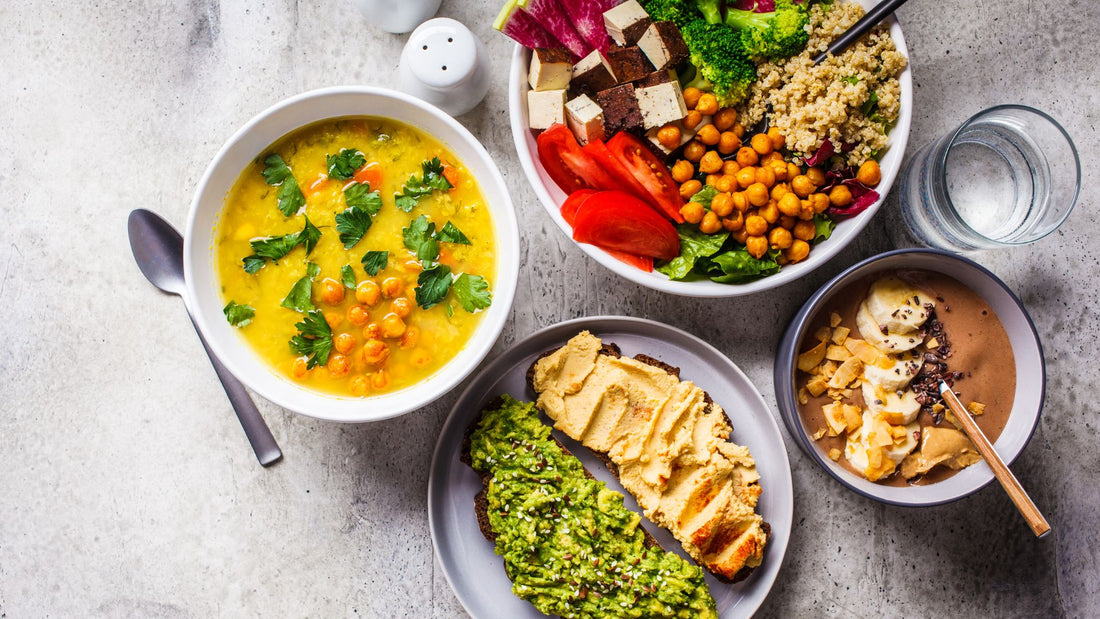Increasing research suggests a wholly plant-based vegan diet might not only improve your overall health but could also be particularly beneficial if you are going through the perimenopause and menopause.
Veganism, a way of eating where you don’t consume any animal-derived foods, is becoming increasingly popular and mainstream now but there have been criticisms in the past that it is a diet that is too restrictive and can potentially lead to some nutritional deficiencies. However, if it is well-planned and contains a good balance of vitamin-rich and fibrous vegetables and fruits; hormone-regulating phytoestrogens, protein-packed pulses and healthy fats like those found in nuts, seeds and vegetable oils it should be a healthy way of eating for everyone. Mounting research also suggests it may have particular benefits for women going through the perimenopause and menopause. That said, there are a few things to bear in mind if you are thinking of switching, whether temporarily or permanently, to a vegan diet.
Our top tips for going vegan
Go easy on the processed vegan foods
The increasing popularity of vegetarian and veganism has led to a growth in packaged and ultra-processed vegan foods. This might be a positive for those looking to pick up a quick and easy vegan meal or snack, however, as with many non-vegan ultra-processed ready meals and supermarket snacks these can potentially be laden with unhealthy additives and trans fats which are there to extend the shelf life of the product. They may also contain starchy components that can impact negatively on your blood sugar levels. Some faux meat products can also be high in fat and salt and, for that reason, should be used in moderation. In short, something like a vegan ‘hotdog’ is still a hotdog and a vegan cake is still a cake – neither of which is likely to have much in the way of nutritional benefits. Making your vegan meals from scratch means you can control exactly what nutrients you are putting in to your body.
Top tip: If you're looking for a simple way to decipher product labels and analyse the health impact of ingredients incorporated in food products, you could try an app like Yuka which provides a simple way to scan products to review their ingredients.
Potential nutrient deficiencies
A balanced and well thought out vegan diet should provide all the nutrients you need but there are a few potential areas where it can be a little bit trickier.
For example:
Vitamin B12 – this is a nutrient that is important for a healthy nervous system which most people get from animal sources including meat, fish, eggs and dairy products. A lack of it can lead to fatigue, muscle weakness, headaches, mouth ulcers and psychological problems.1 These symptoms are also common signs of perimenopause and menopause so you want to ensure you are getting enough vitamin B12 so as not to confuse a deficiency, or low levels, of this nutrient with symptoms triggered by hormone imbalances. Plant foods do not naturally contain vitamin B12 but it is possible to get it from some fortified foods such as breakfast cereals and some nutritional yeasts. Taking a daily supplement of vitamin B12 will help top up your levels.
Iron – this is a mineral that is found in plant-based sources (including pulses, dark leafy greens and nuts) but these are not as well absorbed by the body as animal sources of iron. To help increase your absorption of plant-based iron eat it with vitamin C rich foods like citrus fruits, peppers or drink a glass of orange juice.
Omega 3 fatty acids – have been shown to help reduce the risk of cardiovascular disease and the most potent sources are found in oily fish like salmon and mackerel. Plant based sources include flaxseeds, tofu and soy. Taking a supplement derived from algae, rather than fish, should help top-up your intake.
A brief word about rice
Rice can be a very healthy part of a vegan diet plan. Except if you are perimenopausal or menopausal. This is because rice, particularly white rice, is super-starchy and raises glycaemic index (GI) – the food rating system which shows how quickly your blood sugar (glucose) is raised. Research also suggests that regularly eating rice puts you at an increased risk of type 2 diabetes. Whilst perimenopause or menopause doesn’t cause type 2 diabetes the hormonal changes during these transitional times can lead to gaining more weight around your abdomen and cause blood pressure to rise which are both risk factors for type 2 diabetes2. Basmati and brown rice has slightly lower GI but eating too much of it can also cause a spike in GI. Why this is significant is that declining and fluctuating levels of oestrogen during menopause can interfere with the body’s ability to use glucose effectively and so have a big impact on blood glucose management and insulin sensitivity. Ideally, starch should be avoided where possible and you should aim to get your carbohydrates from foods like vegetables and pulses.
Nutritional yeast
Nutritional yeast is a form of deactivated yeast which comes in the form of either powder or flakes. Described as having a cheesy, nutty, savoury flavour nutritional yeast can be a helpful and highly nutritious addition to a vegan eating plan. A good source of vitamins and minerals, protein and fibre (around 2 tablespoons of it contains roughly 20% of your daily fibre intake) it is commonly used as a vegan cheese flavouring it can also be added to stews, soups and casseroles to add seasoning. Many nutritional yeasts are also fortified with vitamin B12.
How much you use will be largely down to your individual preference and taste but maybe start by using a teaspoon full and try adding more as or when you feel you need it in a dish. Some suggested ways of using it include as an ingredient in making a vegan ‘cream cheese’ (see below), adding it to a risotto in place of Parmesan or a macaroni ‘cheese’-inspired dish, a nut roast or vegan stuffing.
Vegan meal suggestions: 5 days of plant-based dishes
Many of us have already actively moved towards eating less meat but if going completely free of animal products (no meat, fish, cheese, milk, eggs, butter, mayonnaise, ice cream etc) feels overwhelming here’s a list of suggested vegan meals and snacks to make the transition easier. You don’t have to commit to a vegan diet for life but it may be worth trying it out for a couple of months, even weeks, to see if it does have a positive effect on your menopausal symptoms and health generally.
Vegan breakfast ideas
- Sliced apple topped with peanut or other nut butter such as almond or cashew (but choose ones without added salt)
- Granola made with nuts and seeds with added coconut cream (a thicker version of coconut milk, available from most supermarkets and health food shops) topped with a sprinkling of cinnamon
- A vegan fry-up made with mushrooms, tomatoes, baked beans and scrambled tofu3
- A smoothie made from raspberries (frozen or fresh), avocado, coconut milk and chia seeds
- Avocado and chickpea toast: Mix an avocado with a tablespoon of chickpeas and add lemon juice and salt and pepper. Blend to your preferred consistency and spread over 1 slice of either sourdough, pumpernickel or dark rye toast or bread.
Vegan lunch ideas
- Japanese style noodles: Edamame (soy) beans (most supermarkets stock frozen ones or you can buy them fresh from Asian supermarkets and/or farmer’s markets). Defrost the beans, if using frozen ones, and mix with spring onion, beansprouts, cucumber and coriander. Make a dressing from Mirin (a rice wine used in Japanese cooking widely available in most supermarkets), tamari (similar to soy sauce but with a higher concentration of soybeans), lemon juice and fresh chopped red chilli. Serve with soba noodles (Japanese style noodles made from buckwheat).
- Stuffed courgettes: slice the courgettes lengthways and scoop out a channel of flesh from the centre. Season with herbs and spices of your choice (eg. oregano, paprika, coriander) and bake for 10 minutes in the oven. Then add diced tomatoes and spring onions with some torn basil leaves and bake for another five minutes. Garnish with flaxseeds or pumpkin seeds.
- A Chinese-style stirfry: made with chopped onions, cabbage, peppers, bean sprouts and water chestnuts.
- A vegetable bake: Put diced butternut squash, beetroot and green beans drizzled with rapeseed oil in the oven for around 25-35 minutes. Garnish with toasted pumpkin seeds.
- A salad made with asparagus, orange, mint, almond flakes seasoned with salt and pepper.
Vegan dinner ideas
- Vegan chilli. Sautee chopped onion, celery and sweet potato in olive oil and add ½ a teaspoon each of cumin, paprika, chilli powder and 2 tablespoons of tomato puree. Mix well and add a selection of beans (kidney and black beans work well). Heat through and serve with sliced avocado and lime wedges.
- Pesto pasta. Whizz up kale, basil, garlic, pumpkin seeds, olive oil, lemon juice and nutritional yeast in a blender and then lightly fry the blitzed up ingredients. Serve with a veggie pasta made from hearts of palms or courgettes or konjac pasta (made from the starchy roots of the konjac plant).
- Vegan curry. Sauté onion and add grated ginger and garlic. Chop a selection of vegetables such as sweet potato, cauliflower, broccoli, carrots and add them to the onion, ginger and garlic. Mix in a tin of rinsed lentils, add Thai red curry paste followed by coconut milk and let it simmer for around 15 minutes until the lentils and vegetables soften. Add spinach around five minutes before serving and allow it to wilt down into the dish. Serve with quinoa and garnish with coriander.
- Vegan tagine. Fry courgettes and tomatoes in a little olive oil. Add a tin of rinsed chickpeas followed by a teaspoon each of ground cinnamon, coriander and cumin. Stir well and add a handful of raisins with around 150ml of vegan stock. Cook until the vegetables have softened and a few minutes before serving add peas to the mix. Serve with quinoa.
- Chickpea stew. Sauté red onion and add chopped garlic and red chilli. Mix in ½ teaspoon of ground turmeric and garam masala. Mix well. Add a tin of chopped tomatoes and 2 tablespoons of tomato puree and allow the mixture to heat through. Add a can of drained and rinsed chickpeas and a large helping of spinach (frozen or fresh).
Vegan snack and sides ideas
- Celery sticks or dried dates stuffed with nut butter
- Soybeans roasted with garlic powder and/or cumin
- Walnuts and dates finely chopped
- Kimchi: you can buy this ready made in some shops or farmer’s markets or you can make your own by shredding cabbage and spring onions and putting them in a mason jar with added ginger, garlic, salt and chilli flakes and refrigerate for between one to five days.
- Make a vegan ‘cream cheese’ by soaking cashews in water overnight. Drain them, add lemon juice and nutritional yeast and blitz in the blender. (Eat with grilled asparagus or carrot and celery sticks).
- Guacamole: mix avocado, diced tomato and red onion with lime juice, parsley and season with salt and pepper. Some people add garlic but if you are not a fan leave it out.
References
- https://www.nhs.uk/conditions/vitamin-b12-or-folate-deficiency-anaemia/
- https://www.bmj.com/content/344/bmj.e1454
- https://www.bbcgoodfood.com/recipes/tofu-scramble



